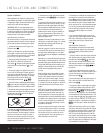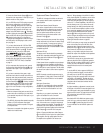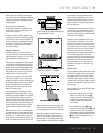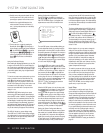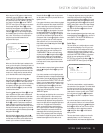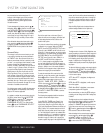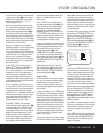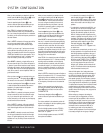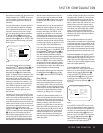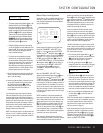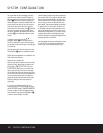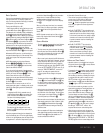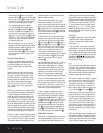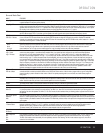
SYSTEM CONFIGURATIONSYSTEM CONFIGURATION
24 SYSTEM CONFIGURATION24 SYSTEM CONFIGURATION
When you have completed your selection for the front
channel, press the
¤
Navigation Button o on the
remote to move the cursor to
CENTER.
Press the
‹
/
›
Navigation Button o on the
remote
to select the option that best describes your sys-
tem, based on the speaker definitions shown below.
When SMALL is selected, low-frequency center
channel sounds will be sent only to the subwoofer out-
put. If you choose this option and there is no subwoofer
connected, you will not hear low-frequency sounds from
the center channel.
When
LARGE is selected, a full-range output will be
sent to the center speaker output, and NO center
channel signal will be sent to the subwoofer output.
NOTE: If you choose Logic 7 as the surround mode
for the particular input source for which you are con-
figuring your speakers, the AVR 430 will not make the
LARGE option available for the center speaker. This is
due to the requirements of Logic 7 processing, and
does not indicate a problem with your receiver.
When
NONE is selected, no signals will be sent to
the center channel output. The receiver will operate in
a “phantom” center channel mode and center channel
information will be sent to the left and right front chan-
nel outputs. When only front left and right speakers are
used, with no center or surround speakers, VMAx is a
good alternative mode.
When you have completed your selection for the cen-
ter channel, press the
¤
Navigation Button o on
the remote to move the cursor to
SURROUND.
Press the
‹
/
›
Navigation Button o on the remote
to select the option that best describes the surround
speakers in your system based on the speaker
definitions shown on this page.
When
SMALL is selected, low-frequency surround
channel sounds will be sent to the subwoofer output
only. If you choose this option and there is no sub-
woofer connected, you will not hear any low-frequency
sounds from the surround channels.
When
LARGE is selected, a full-range output will
be sent to the surround channel outputs, and NO sur-
round channel signals will be sent to the subwoofer
output.
When
NONE is selected, surround sound informa-
tion will be split between the front left and front right
outputs. For optimal performance when no surround
speakers are in use, the Dolby 3 Stereo mode should
be used.
When you have completed your selections for the
main surround channels, press the
¤ Navigation
Button
o on the remote to move the cursor to
SURR BACK. This line serves two functions:
It not only configures the setting for the surround
back channels when they are present; it also tells
the AVR 430’s processing system to configure the
unit for either 5.1 or 6.1/7.1 operation.
Press the
‹/› Navigation Button o on the
remote to select the option that best describes the
speakers in use at the left and right back surround
positions based on the definitions on this page:
When
NONE is selected, the system will adjust so
that only 5.1-channel surround processing/decoding
modes are available and the surround back amplifier
channels will not be used. When this is the case for
your system, you may wish to take advantage of the
availability of this amplifier channel pair for use in pow-
ering a second set of speakers that have their source
selected by the AVR 430’s multiroom control system.
See page 36 for more information.
When
SMALL is selected, the system will adjust so
that the full complement of 6.1/7.1 surround processing
/
decoding modes are available, and low-frequency
information below the crossover point will be sent to
the subwoofer output. If you choose this option and
there is no subwoofer connected, you will not hear
any low-frequency sounds from the surround back
channels.
When
LARGE is selected, the system will adjust so
that the full complement of 6.1/7.1 surround process-
ing/decoding modes are available, and a full-range
signal will be sent to the surround back channels, with
no low-frequency information sent to the subwoofer
output.
When you have completed your selection for the
back surround channels, press the
¤
Navigation
Button
o on the remote to move the cursor to
SUBWOOFER.
Press the
‹
/
›
Navigation Button o on the
remote to select the option that best describes your
system.
The choices available for the subwoofer position will
depend on the settings for the other speakers, particu-
larly the front left/right positions.
If the front left/right speakers are set to
SMALL,
the subwoofer will automatically be set to
SUB,
which is the “on” position.
If the front left/right speakers are set to
LARGE,
three options are available:
• If no subwoofer is connected to the AVR 430,
press the
‹
/
›
Navigation Button o on the
remote so that
NONE appears in the on-screen
menu. When this option is selected, all bass infor-
mation
will be routed to the front left/right “main”
speakers.
• If a subwoofer is connected to the AVR 430, you
have the option to have the front left/right “main”
speakers reproduce bass frequencies at all times,
and have the subwoofer operate only when the
AVR 430 is being used with a digital source that
contains a dedicated low-frequency effects, or LFE
soundtrack. This allows you to use both your main
and subwoofer speakers to take advantage of the
special bass sounds created for some movies.
Press
‹
/
›
Navigation Button o on the
remote so that
SUB (LFE) appears in the
on-screen menu.
• If a subwoofer is connected and you wish to use it
for bass reproduction in conjunction with the main
front left/right speakers, regardless of the type of
program source or Surround mode you are listen-
ing to, press the
‹
/
›
Navigation Button o on
the remote so that
SUB L/R+LFE appears
in the on-screen menu. When this option is select-
ed, a full-range signal will be sent to the front
left/right “main” speakers, and the subwoofer will
receive LFE information and the bass frequencies
under the selected crossover point.
When all initial speaker “size” settings have been
made, you now have the option to take advantage of
the AVR 430’s Quadruple Crossover system, which
allows individual crossover settings to be made for
each speaker grouping. The low-frequency crossover
point is set by the design of your speakers. Depending
on the design and driver complement of your speakers,
it is defined as the frequency which is either the lowest
possible frequency the speaker is capable of repro-
ducing, or the frequency at which sound is sent to the
speaker’s internal low-frequency driver, as opposed to
the midrange driver.
Before making any changes to the settings for
the crossover point, we suggest that you find the
crossover point for the speakers in each of the four
groupings, front left/right, center front, surround and
surround back, by looking at the specifications page
of each speaker’s owner’s manual, by getting that
information from the manufacturer’s Web site, or
by contacting your dealer or the manufacturer’s
customer service department. You will need this figure
to accurately configure the next group of settings.



